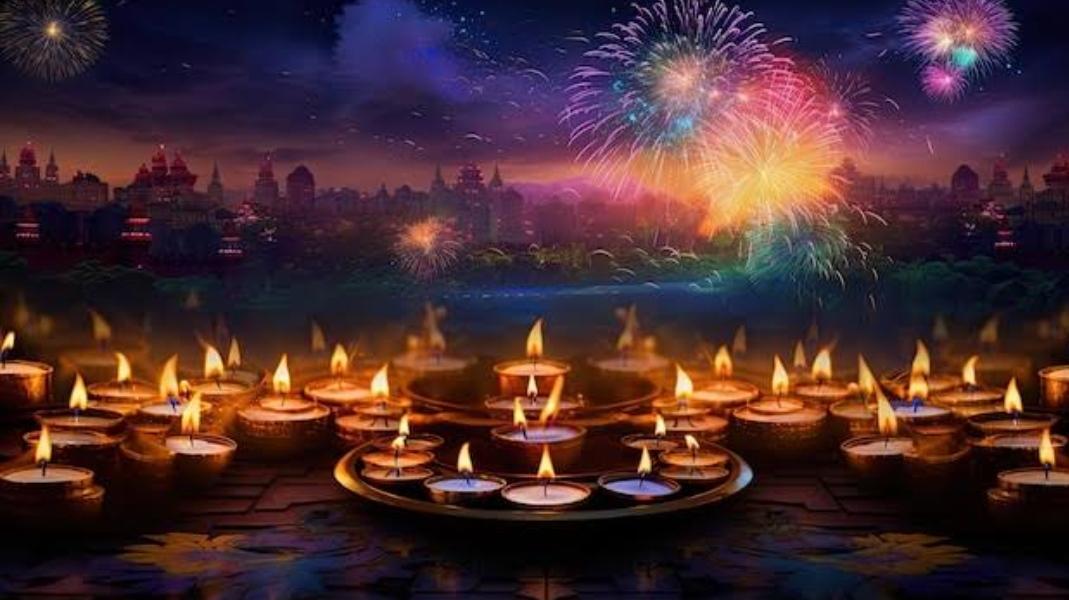Diwali, also known as Deepavali, is one of the most important and widely celebrated festivals in India and across the world. It is known as the "Festival of Lights" and symbolizes the victory of light over darkness, good over evil, and knowledge over ignorance. Celebrated by Hindus, Sikhs, Jains, and Buddhists, Diwali is a time of joy, unity, and gratitude. It usually falls in October or November, according to the lunar calendar, and its celebrations span five days, each with its own significance and rituals.
Origins and Significance
Diwali has its roots in ancient Hindu mythology and is associated with several legends, each adding to the festival's cultural richness. The most popular story comes from the epic Ramayana, where Diwali marks the return of Lord Rama, his wife Sita, and brother Lakshmana to their kingdom of Ayodhya after a 14-year exile. The people of Ayodhya welcomed them with rows of lamps, which symbolizes the beginning of the Diwali tradition.
In other parts of India, Diwali celebrates the goddess Lakshmi, the goddess of wealth and prosperity. For Sikhs, Diwali is associated with the release of Guru Hargobind Ji from imprisonment, while for Jains, it marks the day Lord Mahavira attained Nirvana, or spiritual liberation. The Buddhist festival of Ashok Vijaya Dashami, observed by some Buddhist groups, also aligns with Diwali.
### The Five Days of Diwali
1. **Dhanteras**: The first day marks the beginning of Diwali with prayers for health, wealth, and prosperity. People clean and decorate their homes, buy new utensils, jewelry, or household items as symbols of prosperity, and worship Lord Dhanvantari, the god of health and healing.
2. **Naraka Chaturdashi or Choti Diwali**: This day celebrates the victory of Lord Krishna over the demon Narakasura, symbolizing the triumph of good over evil. People engage in early morning rituals and light diyas (oil lamps) to drive away evil spirits.
3. **Lakshmi Puja**: The main day of Diwali is dedicated to Lakshmi, the goddess of wealth. Families perform a ritualistic worship or "puja" to invite prosperity and well-being. Houses are illuminated with diyas, decorated with rangoli (intricate patterns created with colored powders or flower petals), and firecrackers are set off to celebrate.
4. **Govardhan Puja or Annakut**: This day, observed mainly in North India, commemorates the lifting of Mount Govardhan by Lord Krishna to protect the villagers from a storm. People make elaborate meals and worship the mountain as a symbol of protection and gratitude.
5. **Bhai Dooj**: The last day of Diwali celebrates the bond between brothers and sisters. Sisters perform a tilak ceremony for their brothers, praying for their well-being, and brothers promise to protect their sisters in return. This day is a time to strengthen family bonds.
Diwali Traditions and Customs
**Lighting Lamps and Diyas**: The lighting of diyas, or small clay lamps, is central to Diwali. Diyas are placed in homes, temples, and public spaces to ward off darkness and invite positive energy. Today, many people also use colorful candles and LED lights to decorate their homes and neighborhoods.
**Rangoli Designs**: Rangoli, an art form involving patterns made with colored powders, rice, or flowers, adorns the entrances of homes and temples. This tradition is believed to welcome guests and bring good fortune.
**Exchanging Gifts and Sweets**: Diwali is a time for giving, and people exchange gifts, sweets, and treats with family, friends, and neighbors. Mithai (Indian sweets) like ladoos, barfis, and jalebis are popular, along with savory snacks. This tradition strengthens bonds and spreads joy.
**Fireworks and Sparklers**: Fireworks are an integral part of Diwali celebrations, symbolizing the removal of darkness. Many people enjoy setting off firecrackers and sparklers, though there is a growing awareness of the environmental impact, leading some to choose eco-friendly or noiseless alternatives.
**Charity and Acts of Kindness**: Diwali is also a time for charity and giving to those in need. Many people donate to charities, distribute food, and help those less fortunate, embodying the festival’s spirit of kindness and compassion.
Environmental Awareness and Green Diwali
As environmental consciousness grows, so does awareness about the effects of firecrackers on air quality, noise pollution, and animal welfare. Many people are choosing to celebrate a "Green Diwali," focusing on sustainable practices. Using LED lights, opting for natural rangoli colors, planting trees, and choosing biodegradable decorations are all ways to reduce the festival's environmental impact.
Diwali Across the World
Diwali is celebrated globally by the Indian diaspora and other communities that embrace its universal message of light and hope. In countries like Nepal, Sri Lanka, Malaysia, Singapore, Fiji, Trinidad and Tobago, and the UK, Diwali is an important cultural event, and in many places, it is even recognized as a public holiday. Major cities worldwide, including New York, London, and Sydney, host public Diwali celebrations that include fireworks, cultural performances, and community gatherings.
Conclusion
Diwali is a festival that transcends religious boundaries, bringing people together in celebration of life, hope, and the human spirit. Rooted in traditions but evolving with time, Diwali remains a testament to cultural diversity, unity, and shared human values. Whether through lighting lamps, sharing sweets, or performing acts of kindness, Diwali reminds us that light will always overcome darkness, and good will prevail over evil.

